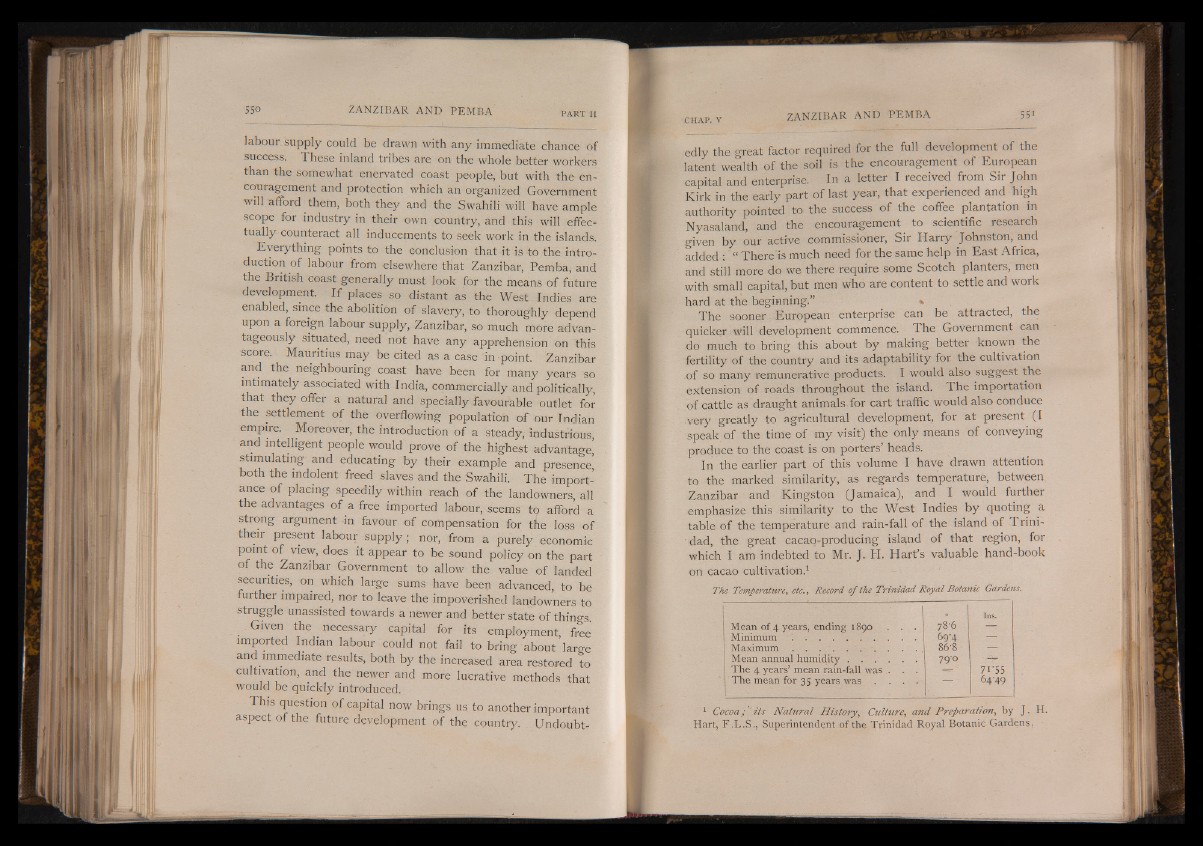
labour supply could be drawn with any immediate chance of
success. These inland tribes are on the whole better workers
than the somewhat enervated coast people, but with the encouragement
and protection which an organized Government
will afford them, both they and the Swahili will have ample
scope for industry in their own country, and this will effectually
counteract all inducements to seek work in the islands.
Everything points to the conclusion that it is to the introduction
of labour 'from elsewhere that Zanzibar, Pemba, and
the British coast generally must look for the means of future
development. I f places so distant as the West Indies are
enabled, since the abolition of slavery, to thoroughly depend
upon a foreign labour supply, Zanzibar, so much more advantageously
situated, need not have any apprehension on this
score. Mauritius may be cited as a case in -point. Zanzibar
and the neighbouring coast have been for many years so
intimately associated with India, commercially and politically,
that they offer a natural and specially favourable outlet for
the settlement of the overflowing population o f our Indian
empire. Moreover, the introduction of a steady, industrious
and intelligent people would prove of the highest advantage’
stimulating- and educating by their example and presence
both the indolent freed slaves and the Swahili. The importance
of placing speedily within reach of the landowners, all
the advantages of a free imported labour, seems to afford a
strong argument in favour of compensation for the loss of
their present labour supply; nor, from a purely economic
point of view, does it appear to be sound policy on the part
of the Zanzibar Government to allow the value of landed
securities, on which large sums have been advanced, to be
further impaired, nor to leave the impoverished landowners to
struggle unassisted towards a newer and better state of things
Given the necessary capital for its employment, free
imported Indian labour could not fail to bring about’ large
and immediate results, both by the increased area restored to
cultivation, and the newer and more lucrative methods that
would be quickly introduced.
This question of capital now brings us to another important
aspect of the future development of the country. Undoubtedly
the great factor required for the full development of the
latent wealth of the soil is the encouragement of European
capital and enterprise. In a letter I received from Sir John
Kirk in the early part of last year, that experienced and high
authority pointed to the success of the coffee plantation in
Nyasaland, and the encouragement to scientific research
given by our active commissioner, Sir Harry Johnston, and
added : “ There is much need for the same help in East Africa,
and still more do we there require some Scotch planters, men
with small capital, but men who are content to settle and work
hard at the beginning.” *
The sooner European enterprise can be attracted, the
quicker will development commence. The Government can
do much to bring this about by making better known the
fertility of the country and its adaptability for the cultivation
of so many remunerative products. I would also suggest the
extension of roads throughout the island. The importation
of cattle as draught animals for cart traffic would also conduce
very greatly to agricultural development, for at present (I
speak of the time of my visit) the only means of conveying
produce to the coast is on porters’ heads.
In the earlier part of this volume I have drawn attention
to the marked similarity, as regards temperature, between
Zanzibar and Kingston (Jamaica), and I would further
emphasize this similarity to the West Indies by quoting a
table of the temperature and rain-fall of the island of Trinidad,
the great cacao-producing island of that region, for
which I am indebted to Mr. J. H. Hart’s valuable hand-book
on cacao cultivation.1
The Temperature, etc., Record o f the Trinidad Royal Botanic Gardens.
1
„ Ins.
Mean of 4 years, ending 1890 . . . 78-6 —
M in im um .............................................. 69-4 I—
Maximum . . . . . . . . . . . 86-8 B .
Mean annual humid ity ..........................
The 4 years’ mean rain-fall was . . .
790 fjjij •
I S 71-55
The mean for 35 years was . . . . ■ Hff. "' • 64-49
1 Cocoa;' its Natural History, Culture, and Preparation, by J. H.
Hart, F.L.S., Superintendent of the Trinidad Royal Botanic Gardens,